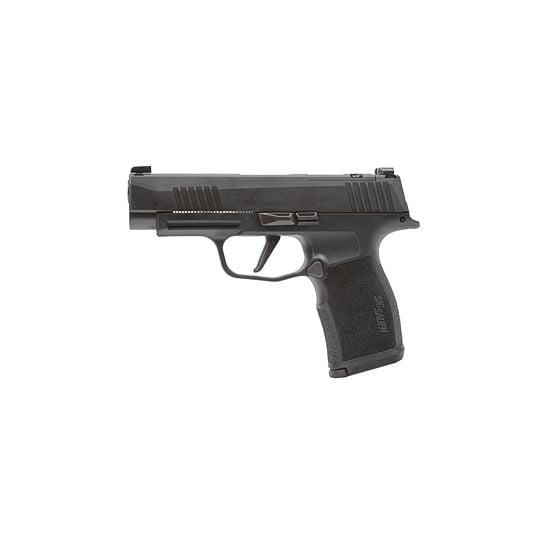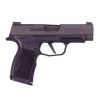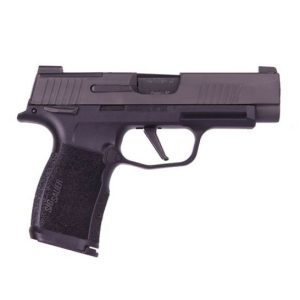Sig Sauer P365 9mm Pistol, 3.7" Barrel, Night Sights, Black – 365XL9BXR3PMS10 For Sale
$619.99
The Sig Sauer P365 9mm Pistol, model 365XL9BXR3PMS10, is an evolution of the P365 series, setting a new standard for concealed-carry guns with the P365 XL. As part of the XSeries, it features a refined design with a 3.7-inch barrel and the advanced 365 XSeries grip module, which includes an extended beavertail and integrated magwell for better handling and comfort. The P365 XL maintains ease of concealment with minimal increases in length and height compared to the original P365. It continues the P365’s tradition of a crisp trigger pull, enhanced by the new X signature flat profile trigger. With night sights, a sleek black finish, and ergonomic improvements, the P365 XL delivers performance and precision tailored to the needs of serious firearm enthusiasts.
What is the difference between P365 and P365 XL?
The primary differences between the SIG Sauer P365 and the P365 XL are related to size, capacity, and features:
1. **Size and Weight**:
– **P365**: More compact, with a shorter barrel length (3.1 inches) and an overall length of about 5.8 inches. It is designed for easy concealment.
– **P365 XL**: Slightly larger, featuring a longer barrel (3.7 inches) and an overall length of approximately 6.6 inches, offering improved accuracy and shootability.
2. **Capacity**:
– **P365**: Comes with a standard 10-round magazine, but can accommodate extended magazines.
– **P365 XL**: Comes with a standard 12-round magazine and can also use extended magazines, increasing its capacity further.
3. **Grip and Ergonomics**:
– **P365 XL**: Has a longer grip, which can provide a more comfortable and stable hold, especially for users with larger hands.
4. **Trigger**:
– **P365 XL**: Often features a flat-faced trigger which some shooters prefer for its feel and break compared to the curved trigger on the P365.
5. **Sight Options**:
– **P365 XL**: Comes optics-ready, meaning it can accommodate a red dot sight directly without needing additional modification.
These differences make the P365 more suitable for deep concealment, while the P365 XL offers a balance between concealability and performance, catering to those who prefer a slightly larger firearm with additional features.
Is the SIG P365 XL a good carry gun?
The SIG P365 XL is generally considered a good carry gun by many firearm enthusiasts due to several factors:
1. **Size and Concealability**: The P365 XL is compact yet offers a slightly larger frame and grip than the original P365, which can improve handling and control while still being easy to conceal.
2. **Capacity**: It has a high capacity for a pistol of its size, typically holding 12+1 rounds, with optional extended magazines.
3. **Ergonomics**: It features a comfortable grip and well-designed controls that make it user-friendly for both shooting and carrying.
4. **Trigger and Sights**: The trigger is known for being smooth and the pistol often comes with good-quality sights out of the box, enhancing accuracy.
5. **Versatility**: It often comes optics-ready, allowing for easy attachment of red dot sights.
Overall, the SIG P365 XL is often praised for its balance of size, capacity, and performance, making it a popular choice for concealed carry. However, personal preferences and specific needs should always guide firearm selection.
Is SIG better than Glock?
The choice between SIG Sauer and Glock firearms often comes down to personal preference and specific needs, as both are reputable brands offering high-quality products. Here are some considerations:
1. **Design and Ergonomics**:
– SIG Sauer is often praised for its ergonomic design and solid feel.
– Glock, known for its simplicity and reliability, is favored for its lightweight and easy maintenance.
2. **Trigger Systems**:
– SIG offers pistols with various trigger types (e.g., DA/SA, striker-fired), allowing for a broad choice.
– Most Glocks feature a consistent striker-fired trigger system.
3. **Price and Value**:
– Glocks are generally more budget-friendly while maintaining quality.
– SIG pistols often come with a higher price tag, reflecting additional features or all-metal construction on some models.
4. **Intended Use**:
– For law enforcement and military use, both brands are popular choices.
– For personal defense or concealed carry, preference can vary widely among users.
Ultimately, determining which brand is “better” depends on individual requirements, such as the intended use of the firearm, comfort, and budget. Testing different models from each brand is recommended for making a more informed decision.
Does a SIG P365 XL have a safety?
Yes, the SIG P365 XL has a manual safety variant available. Some models come with a manual thumb safety, while others do not include this feature. Always check the specific model to confirm its features.
Is P365 XL a pocket gun?
The SIG Sauer P365 XL is generally not considered a pocket gun. It is a compact handgun designed for everyday carry, but it is slightly larger than traditional pocket pistols. The P365 XL features a longer slide and barrel compared to the original P365, which makes it more suitable for waistband or holster carry rather than being easily carried in a pocket.
How much should I pay for a P365?
The cost of a Sig Sauer P365 can vary based on factors such as the model variant, condition (new or used), and location. As of the latest data, new P365 models typically range from $500 to $700 USD. Special editions or those with custom features might be priced higher. It’s advisable to check with local gun shops or online firearm retailers for the most accurate pricing. Always ensure compliance with local laws and regulations when purchasing firearms.
Why is the P365 so expensive?
The SIG Sauer P365 can be considered expensive due to several factors:
1. **Quality and Reliability**: SIG Sauer is known for its high-quality firearms with excellent craftsmanship and reliable performance. This reputation can contribute to higher prices.
2. **Innovative Design**: The P365 is praised for its compact design while still offering a relatively high magazine capacity, which is a significant feat of engineering and attracts a premium.
3. **Materials and Manufacturing**: The use of high-grade materials and meticulous manufacturing processes can increase production costs, which are reflected in the retail price.
4. **Demand and Market Position**: The P365 is a popular choice for concealed carry, which can drive demand and affect pricing. Additionally, SIG Sauer positions itself in the market as a premium brand.
5. **Features**: The P365 often includes features like night sights and a good trigger out of the box, which might be additional expenses with other firearms.
These factors together contribute to its higher price point compared to some other handguns.
How many rounds can a SIG P365 XL hold?
The SIG P365 XL typically comes with a flush-fit magazine that can hold 12 rounds. However, it can also accommodate extended magazines that hold up to 15 rounds.
What are the cons of the SIG P365?
The SIG P365 has received positive reviews, but like any firearm, it has its cons. Some noted drawbacks include:
1. **Magazine Capacity Concerns**: Although the P365 boasts a high capacity for its size, some users might find the 10 to 12-round magazine limited compared to larger handguns.
2. **Ergonomics for Larger Hands**: Individuals with larger hands may find the grip of the P365 too small, which can affect comfort and control.
3. **Trigger Feel**: Some users report that the trigger can feel somewhat gritty or heavy at first, requiring a break-in period.
4. **Slide Lock and Release**: The slide lock can be difficult to engage and release, especially for those with weaker hand strength.
5. **Magazine Release**: Some shooters have mentioned that the magazine release is stiff or slightly awkward to operate without altering grip.
6. **Recoil**: As a subcompact firearm, the P365 can have more perceived recoil compared to larger handguns, which may impact follow-up shot speed and accuracy.
7. **Sight Regulation**: There have been occasional reports of sights being slightly off, requiring adjustment for precise shooting.
8. **Price Point**: The P365 is relatively expensive compared to other subcompact pistols, which may be a consideration for budget-conscious buyers.
It’s important to note that individual experiences may vary, and potential users should test the firearm themselves to see if these cons impact their use.
Why is SIG so expensive?
SIG, referring to SIG Sauer firearms or SIG as a company, is generally considered expensive for several reasons:
1. **Quality and Craftsmanship**: SIG Sauer is renowned for its high-quality materials and craftsmanship. They use robust materials and detailed manufacturing processes to ensure durability and reliability.
2. **Innovation and Technology**: SIG Sauer invests heavily in research and development, ensuring that their products incorporate the latest innovations and technologies in firearms.
3. **Performance and Reliability**: SIG firearms are known for their excellent performance and reliability under various conditions, making them a preferred choice for military, law enforcement, and civilian use.
4. **Brand Reputation**: With a strong brand reputation, SIG Sauer commands higher prices due to perceived value and customer trust built over years of producing premium products.
5. **Precision and Accuracy**: SIG firearms are often praised for their precision and accuracy, which makes them more desirable and justifies a higher price point.
These factors contribute to the high cost of SIG products, reflecting their positioning as a premium option in the firearms market.
What gun does a cop use?
The type of gun that a police officer uses can vary depending on the country, department, and specific role of the officer. In the United States, a common standard issue firearm for many police officers is a semi-automatic pistol, such as a Glock 17 or Glock 19. However, other models and calibers might also be used, such as the Sig Sauer P320 or the Smith & Wesson M&P. It’s important to note that the choice of firearm is typically determined by the law enforcement agency, based on their policies and requirements.
What gun brand is better than Glock?
The answer to which gun brand is better than Glock is subjective and depends on various factors such as personal preference, intended use, ergonomics, reliability, and price. Brands like Sig Sauer, Smith & Wesson, and Heckler & Koch are often compared to Glock and may be preferred by some users for specific features. Ultimately, the “better” brand varies for each individual based on their unique needs and criteria.
What does XL mean on P365?
On the P365, “XL” refers to a model variant of the SIG Sauer P365 pistol series. The P365 XL is a slightly larger version of the standard P365, featuring an extended slide and barrel, as well as a longer grip that accommodates a higher magazine capacity. This design offers improved accuracy and handling, making it a popular choice for those who prefer a slightly larger concealed carry firearm.
Are P365 and P365XL interchangeable?
The SIG Sauer P365 and P365XL are not completely interchangeable, but they do share several similarities and some compatible parts. Both are part of the P365 series and are designed for concealed carry, but they differ in size and certain features. Here are the key differences and compatibilities:
1. **Size**: The P365XL is larger than the P365. It has a longer slide and barrel and a longer grip frame to accommodate a higher magazine capacity.
2. **Magazine Compatibility**: P365 magazines can be used in the P365XL. However, P365XL magazines will not fit into the P365 without an extension, as they are longer.
3. **Slide and Frame**: The slides and frames of the P365 and P365XL are not directly interchangeable due to differences in length and fitting.
4. **Trigger**: The P365XL comes with a flat trigger, while the P365 typically has a curved trigger. The triggers are not interchangeable directly without modifications.
5. **Accessories**: Some accessories, such as sights or holsters, may be compatible, but this depends on each accessory’s specific design.
In summary, while some components and magazines can be shared, the P365 and P365XL are not fully interchangeable due to their differing sizes and configurations.
What is the difference between Sig P365 and P365X extended mag?
The primary difference between the Sig P365 and P365X extended magazines lies in their capacity and compatibility. The standard Sig P365 magazine typically has a lower capacity compared to the P365X extended magazine, which offers additional rounds due to its extended size. Specifically, the P365X is designed to accommodate the extended magazine, often resulting in an increased grip length for better handling, making it slightly different in terms of overall ergonomics and concealability. The specific capacity can depend on the exact magazine variant, such as 12 or 15 rounds, and should be checked to match your specific requirements.
Be the first to review “Sig Sauer P365 9mm Pistol, 3.7" Barrel, Night Sights, Black – 365XL9BXR3PMS10” Cancel reply
Related products
Sig Sauer P365 XL 9mm
Sig Sauer P365 XL 9mm 12rd 3.7" Pistol, Black – 365XL-9-BXR3-MS



Reviews
There are no reviews yet.